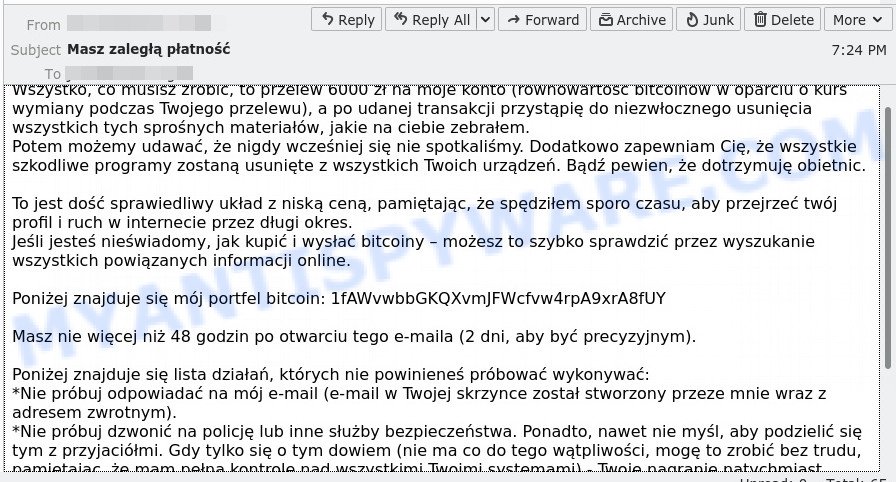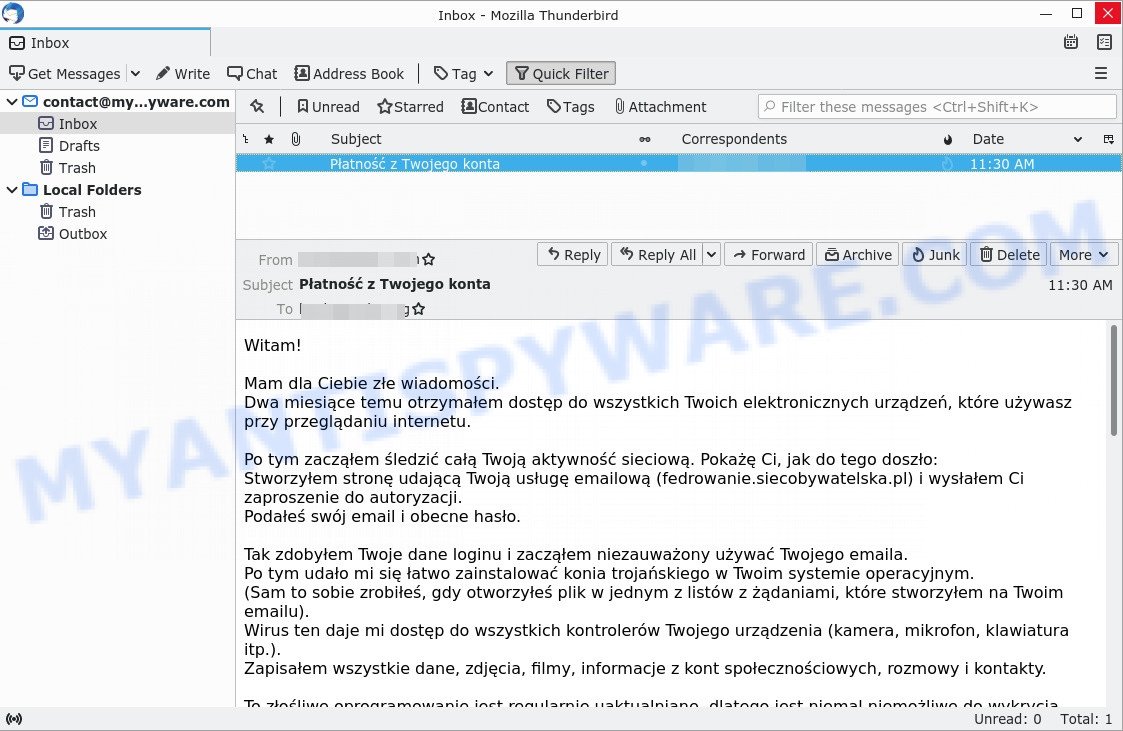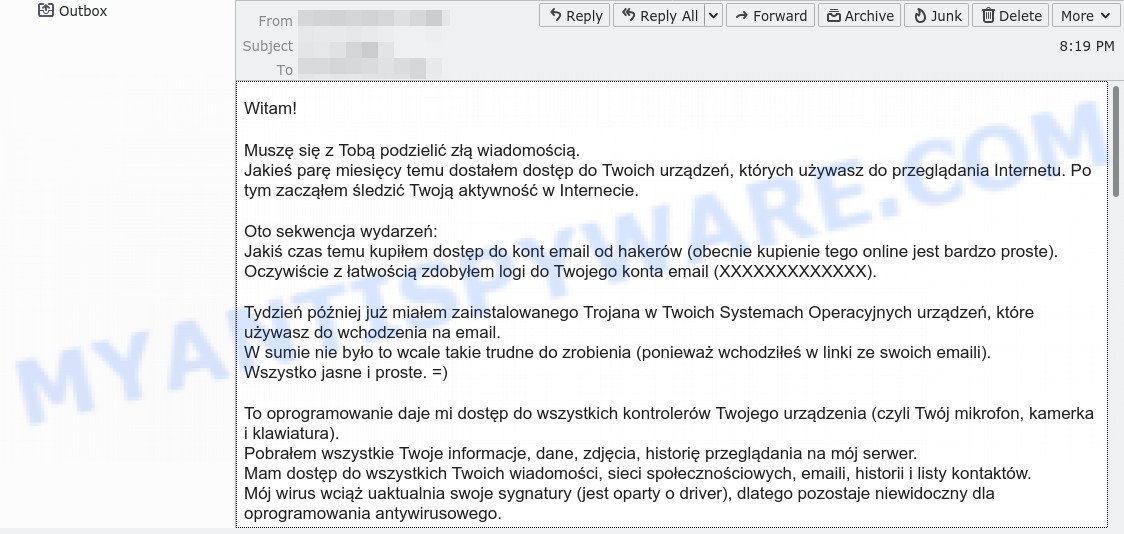What is “Jestem profesjonalnym hakerem” EMAIL?
Jestem profesjonalnym hakerem i z powodzeniem udało mi się zhakować Twój system operacyjny email is a variant of the sextortion scam. Sextortion email scams are targeting email accounts and convincing users they’ve been hacked. Sextortion scams claim that someone has installed malware onto the victim’s computer and they recorded the victim watching porn videos. They threaten to publicize that information if the victim doesn’t pay up — often through a bitcoin payment.
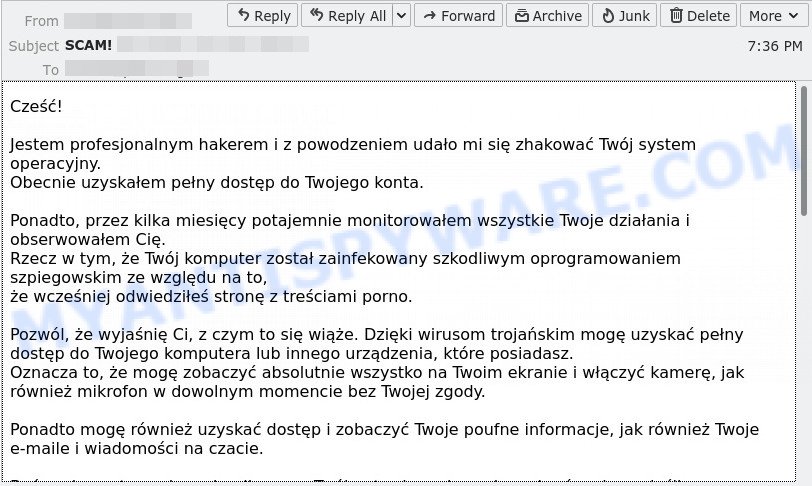
Jestem profesjonalnym hakerem Email Scam
QUICK LINKS
- What is “Jestem profesjonalnym hakerem” SCAM?
- What to do when you receive the scam message?
- How to spot a phishing email?
- Report Scam Email
The Scam in detail
The scam is a new sextortion scam that targets Polish speaking users. This scam is a new variant of the I am a professional hacker Scam.
Text presented in the Jestem profesjonalnym hakerem Scam:
Cześć!
Jestem profesjonalnym hakerem i z powodzeniem udało mi się zhakować Twój system operacyjny.
Obecnie uzyskałem pełny dostęp do Twojego konta.Ponadto, przez kilka miesięcy potajemnie monitorowałem wszystkie Twoje działania i obserwowałem Cię.
Rzecz w tym, że Twój komputer został zainfekowany szkodliwym oprogramowaniem szpiegowskim ze względu na to,
że wcześniej odwiedziłeś stronę z treściami porno.Pozwól, że wyjaśnię Ci, z czym to się wiąże. Dzięki wirusom trojańskim mogę uzyskać pełny dostęp do Twojego komputera lub innego urządzenia, które posiadasz.
Oznacza to, że mogę zobaczyć absolutnie wszystko na Twoim ekranie i włączyć kamerę, jak również mikrofon w dowolnym momencie bez Twojej zgody.Ponadto mogę również uzyskać dostęp i zobaczyć Twoje poufne informacje, jak również Twoje e-maile i wiadomości na czacie.
Być może zastanawiasz się, dlaczego Twój antywirus nie może wykryć mojego złośliwego oprogramowania.
Pozwól, że ci to wyjaśnię: używam szkodliwego oprogramowania opartego na sterownikach, które odświeża swoje sygnatury co 4 godziny,
stąd Twój antywirus nie jest w stanie wykryć jego obecności.Zrobiłem kompilację wideo, która pokazuje po lewej stronie sceny,
w których się radośnie masturbujesz, a po prawej stronie demonstruje film, który wówczas był włączony. 😉Wszystko, czego potrzebuję, to tylko udostępnienie tego filmu wszystkim adresom e-mail i kontaktom messengerowym osób,
z którymi się komunikujesz na swoim urządzeniu lub komputerze. Co więcej, mogę również upublicznić wszystkie Twoje e-maile i historię czatu.Wierzę, że zdecydowanie chcesz tego uniknąć. Oto co musisz zrobić – przelać Bitcoinową równowartość 990€ na moje konto Bitcoin (to raczej prosty proces,
który możesz sprawdzić online w razie gdybyś nie wiedział jak to zrobić).Poniżej znajdują się informacje o moim koncie Bitcoin (portfel Bitcoin): 1KrSuqvZWd7P8rjA7a7TE9gXpS8VpYXhe8
Po przelaniu wymaganej kwoty na moje konto, przystąpię do usuwania wszystkich tych filmów i zniknę z Twojego życia raz na zawsze.
Uprzejmie proszę o upewnienie się, że dokonasz wyżej wymienionego przelewu w ciągu 50 godzin (2 dni +).
Otrzymam powiadomienie zaraz po otwarciu tego maila, wtedy zacznie się odliczanie.Zaufaj mi, jestem bardzo ostrożny, wyrachowany i nigdy nie popełniam błędów.
Jeśli odkryję, że ktoś został przez Ciebie powiadomiony o tej sytuacji, od razu przystąpię do upublicznienia Twoich prywatnych filmów.Powodzenia!
Scammers use email spam to promote this scam and create many new victims. Scammers slightly changed the original text and translated it into Polish, preserving the meaning of the text. The size of the ransom has also changed: now the scammers are demanding 990€ from their victims. In addition, scammers are now using a new bitcoin wallet with the address 1KrSuqvZWd7P8rjA7a7TE9gXpS8VpYXhe8.
Threat Summary
| Name | Jestem profesjonalnym hakerem EMAIL SCAM |
|---|---|
| Type | Bitcoin Blackmail Scam, Sextortion Scam |
| Ransom amount | 990€ |
| Bitcoin address | 1KrSuqvZWd7P8rjA7a7TE9gXpS8VpYXhe8 |
| Distribution method | spam email campaigns |
Examples of such scams
As we have already reported above, there are other variants of scams aimed at Polish speaking users, for example: Niestety, mamy dla Ciebie złe wieści, Witam! Mam dla Ciebie złe wiadomości., Cześć! Niestety, mam dla Ciebie złe wiadomości..
- The “Witaj! Niestety, mamy dla Ciebie złe wieści” message is a new EMAIL SCAM
- The “Witam! Mam dla Ciebie złe wiadomości.” is an email scam
- The “Cześć! Niestety, mam dla Ciebie złe wiadomości” email message is new Bitcoin blackmail scam
- Muszę się z Tobą podzielić złą wiadomością EMAIL SCAM
- Cześć! Niestety, mam dla Ciebie złe wiadomości. EMAIL SCAM
What to do when you receive the scam email
We advice to someone who gets this fraudulence message:
- Do not panic.
- Do not pay a ransom.
- Ignore empty threats.
- Mark the scam email as SPAM/JUNK and then delete it.
- If there’s a link in the scam email, do not click it, otherwise you could unwittingly install malware or ransomware on your computer.
- Report the scam email to Cyber Security Centre, FTC or Police
- If you suspect that your computer is infected with malware, you accidentally clicked on a link in the scam email, or just want to scan your computer for malware, then use one of the free malware removal tools.
How to spot a phishing email?
Phishing emails often share common characteristics; they are designed to trick victims into clicking on a phishing link or opening a malicious attachment. If you know these characteristics, you can detect phishing emails and prevent identity theft.
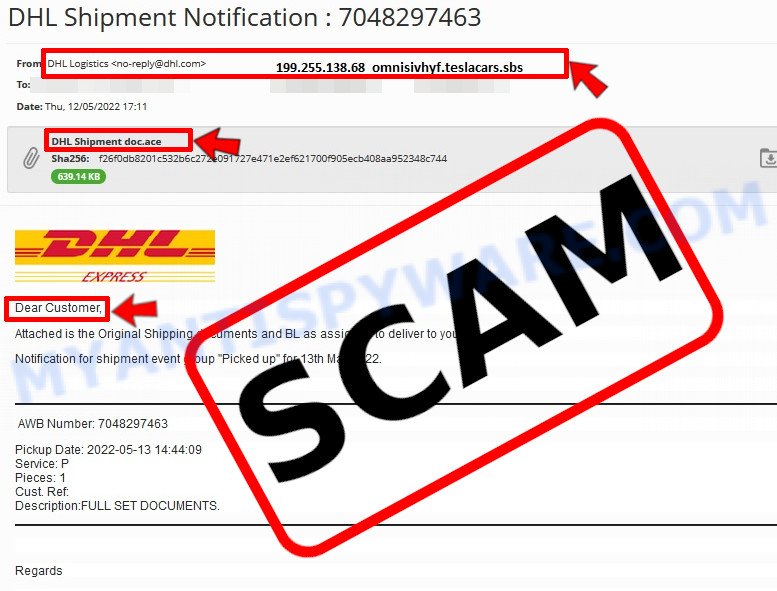
Here are some ways to recognize a phishing email
- Inconsistencies in Email Addresses. The most obvious way how to spot a scam email is finding inconsistencies in email addresses and domain names. If the email claims to be from a reputable company, like Amazon or PayPal, but the email is being sent from a public email domain, such as “gmail.com” it’s probably a scam.
- The domain name is misspelt. Look carefully for any subtle misspellings in the domain name. Like arnazon.com where the “m” has been replaced by “rn”, or paypa1.com, where the “l” has been replaced by “1”. These are common tricks of scammers.
- Generic greetings. If the email starts with a generic “Dear”, “Dear sir” or “Dear madam” that is a warning sign that it might not really be your shopping site or bank.
- Suspicious links. If you have the slightest suspicion an email may be a scam, do not click on the links you see. Instead, hover over the link, but don’t click it. This will pop up a small box that contains the actual URL. This works on image links as well as text links.
- Unexpected attachments. Email attachments should always be verified before clicking. Any attachments should be scanned for viruses – especially if they have an unfamiliar extension or one commonly associated with malware (.zip, .exe, .scr, etc.).
- The email creates a sense of urgency. Creating a false sense of urgency is a common trick of phishing emails. Be suspicious of emails that claim you must call, open an attachment or click a link immediately.
Report Scam Email
If you receive a scam email that is similar but not the same as the example above, make sure you remove any personal info in this message, then post it as comment on this article. This helps us to warn users about current scams, monitor trends and disrupt scams where possible.
